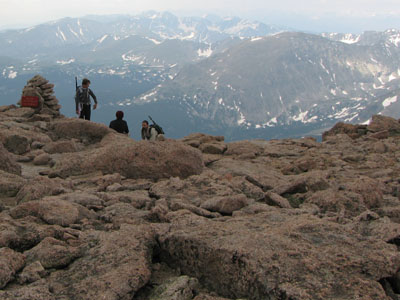| 050 | The Cost is Going Down | 2010-02-04 |

The Colorado Springs Gazettee reported that the Pikes Peak Highway officials were going to ask the City Council to approve a $500 charge to give rides down the mountain.
There are two sides to every story and both views in this case seem legitimate. I think that the fee was proposed for hikers who were uninjured, but called 911 anyway for a rescue because they were unprepared to spend the night out on the mountain.
Barr Trail, if done car to car, is a day’s worth of hiking - it’s a Grade lll. The starting switchbacks as you leave Manitou Springs immediately smack you in the face and make you reconsider why you thought hiking the trail was necessary. The last section (the Golden Stairs) is even steeper than the beginning but adds a touch of spice before gaining the summit. None of the trail is particularly difficult, it is a well maintained Class 1 climb - meaning it is just a walk. But, what the trail lacks in difficulty it makes up for in length.
I have only hiked Barr Trail twice. In ’07 a group of friends and I hiked Pikes in September. I enjoyed the trail so much that I returned in ’08 to hike with my wife and dog. It is a harder day than most other fourteeners because of the length. On both of my hikes there were hikers we passed on the way up and then met them on the way down the mountain who were exhausted. One group, I met on the ’07 trip, got a ride down with some visitors who had driven to the top (we beat them to the parking lot in Manitou) and the ’08 group, I don’t know how they got down, but they didn’t walk!
Nobody starts up the mountain thinking they will need to be rescued. On my first visit some of the hikers in our group reserved seats on the train because they thought the twenty six miles round trip was too big of a day. They didn’t want to take the chance that they would have to be rescued, so they pre-planned their descent. Personally, I believe to climb a mountain you have to go up and down, but I was still proud of the ones in our group who made it to the top. It was a mighty big day for them, probably a bigger day than for me.
Why not give hikers a lift down the mountain? If it is after hours or out of season for the rangers or workers, then it is probably annoying for the rescuers(?). I am sure the workers don’t want to spend their hard earned free time to play taxi driver. They would want to be well paid, hence the $500 per victim.
On the other hand, nobody wants a hiker to have to spend a night on the top of the mountain. Though not necessarily an emergency to rescue the tired hikers, I believe it could be called emergency prevention. The repercussions of someone staying out unprepared could be fatal. When the hikers reach the top they see the train and road; plus the gift shop, restaurant, and restrooms. The summit is quite the little tourist destination. When the facilities are closed it might seem natural for an exhausted hiker to call for help as they stand amidst the alpine civilization. They can’t find a HELP number so they dial - 911.
A few steps that might lessen or eliminate the number of hikers 911-ing from the summit:
- Put signs up at the trailhead, Barr Camp, and the A-frame, warning hikers of the length and difficulty of the trail. Rescue issues could also be addressed.
- Further signage that encourages the use of Barr Camp or backcountry camping - splits hike into a two day or three day trip.
- Provide an after hours shelter at the top for the tired climber to rest or bivouac before starting down the mountain.
- Privatize the rescue operation. Let someone else operate the taxi service and negotiate the fees. Some rides might even be prearranged. The hikers would not benefit, but it would prevent the rescues being a burden to taxpayers.
- Demolish all the buildings on top of the peak, remove the road and the train tracks. If there was no way to perform a quick rescue, the calls might decrease. The summit might also be nicer.
- If someone calls for help we have to rescue them. But, in todays economy everyone wants to know who is going to pay for the rescue. If the hikers had $500 maybe they would have taken the train or bought a better vehicle that might have been able to drive up the mountain. More than likely the hikers would not be able to afford a $500 fee. Of course there could always be a rash of "Pike’s Peak knee" - the closer the hiker gets to the top the more disabling the knee becomes. The rescue call would be imminent.
Hikers and their consciouses are responsible for their actions and their impacts on others. Better education and signage may lessen the calls for help, but some will always try to Rambo it to the summit and call for help to spite all.
Happy Trails, and see you back in the Manitou parking lot!